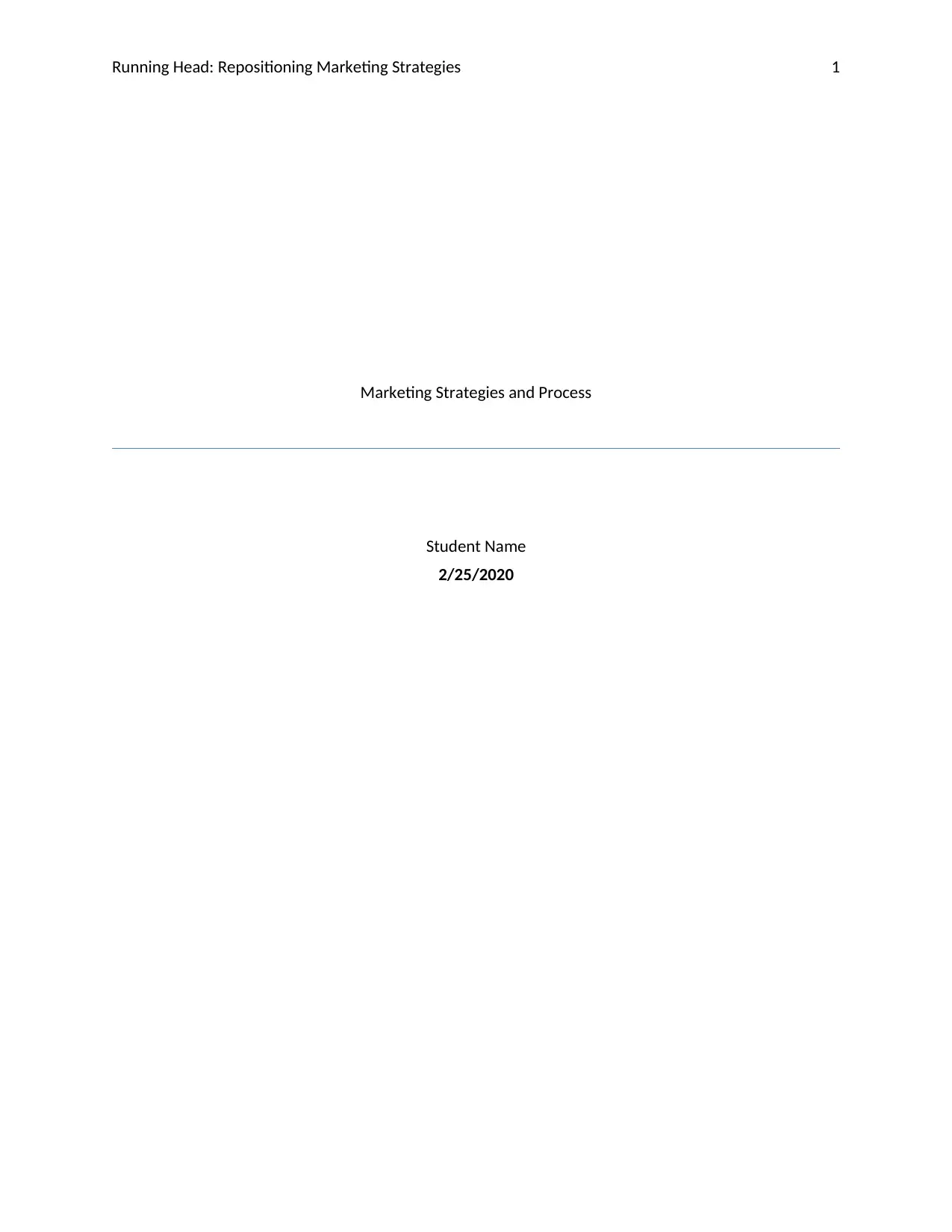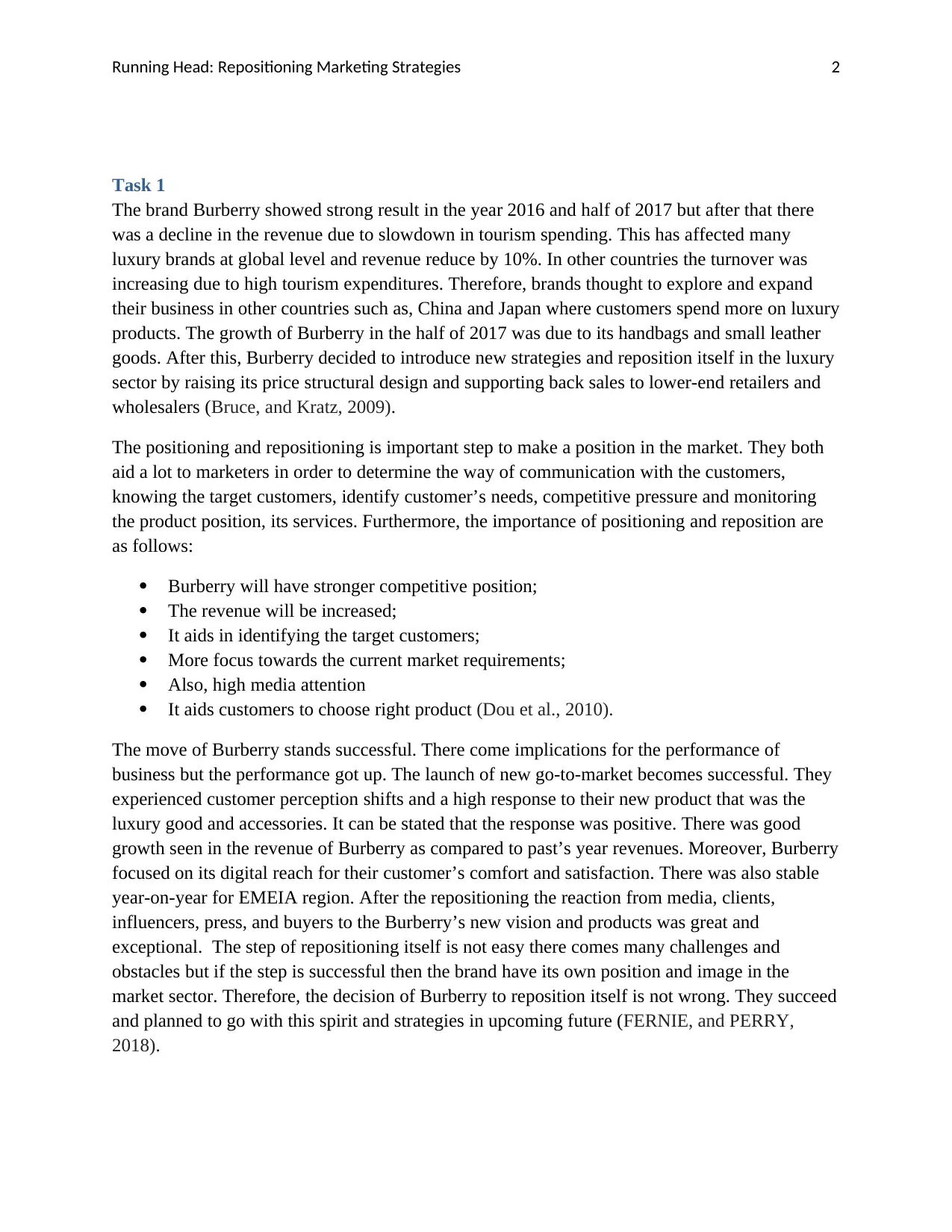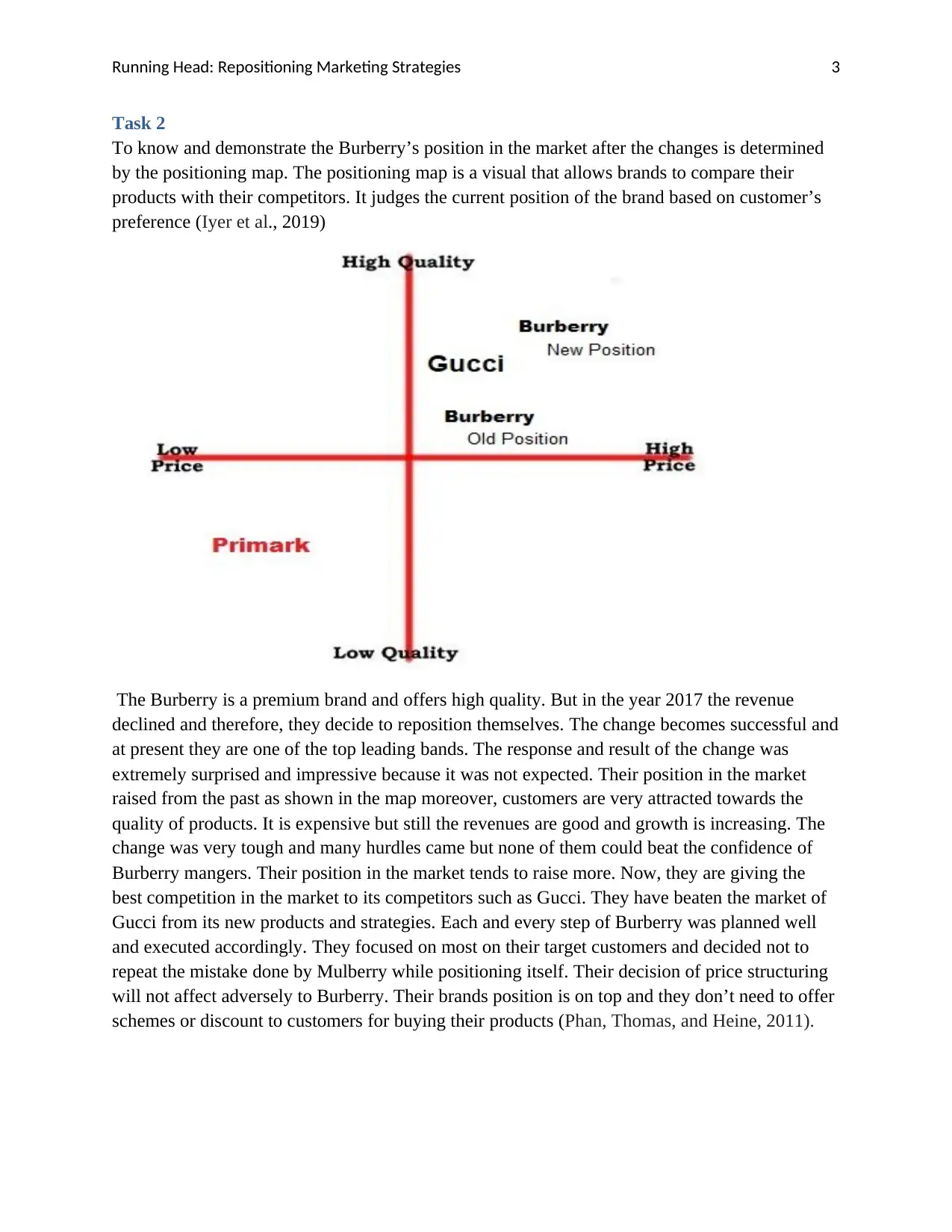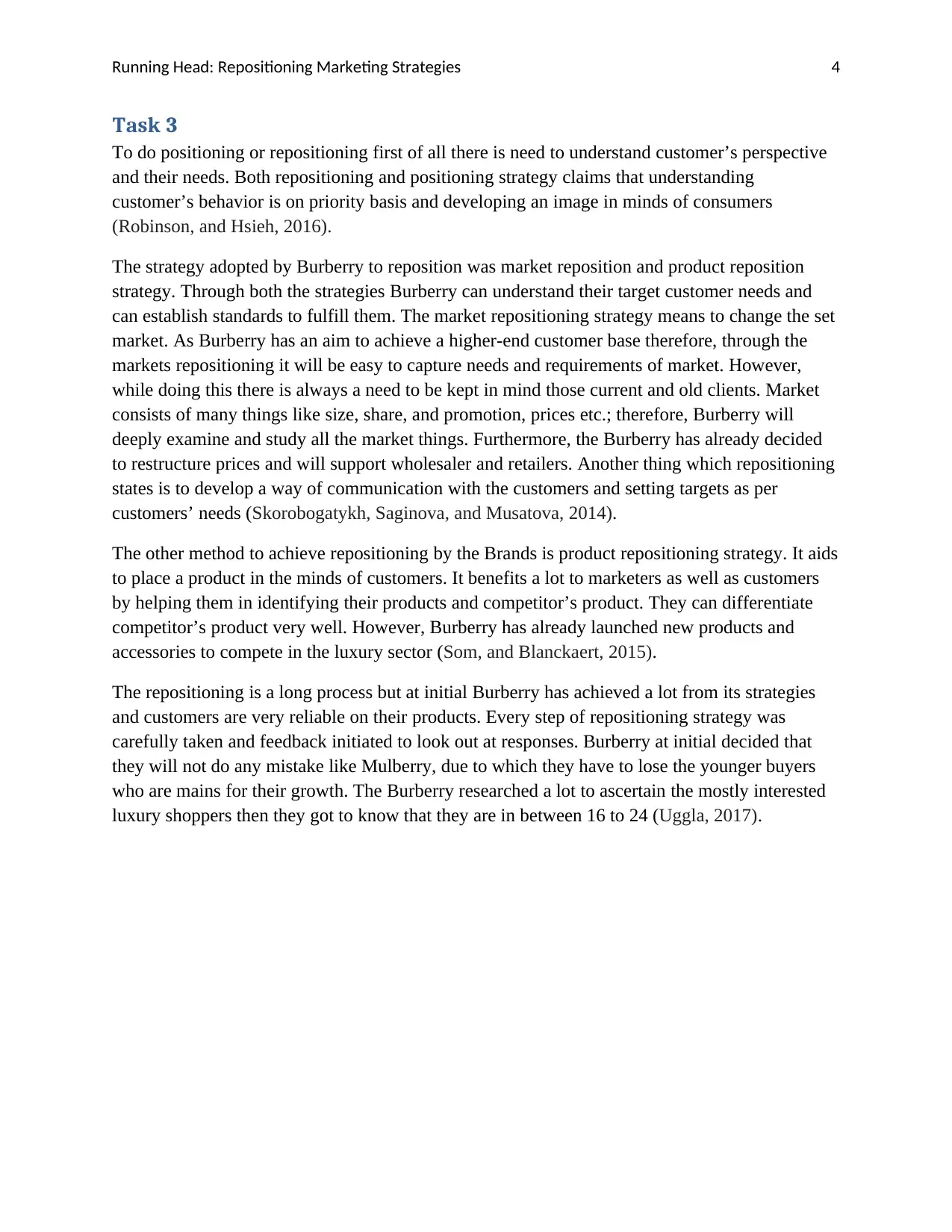Case Study Analysis: Burberry's Marketing Repositioning Strategies
VerifiedAdded on 2022/08/10
|5
|1545
|254
Case Study
AI Summary
This case study examines Burberry's repositioning strategy, focusing on its transition within the luxury fashion sector. The analysis begins with an overview of Burberry's performance, highlighting revenue declines due to shifts in tourism spending and the subsequent decision to reposition the brand. The study delves into the importance of positioning and repositioning in the market, emphasizing competitive advantages, revenue enhancement, and customer targeting. It details Burberry's successful implementation of new strategies, including product repositioning and an increased focus on digital reach, to achieve a positive shift in customer perception and revenue growth. Furthermore, the case study explores the use of positioning maps to visualize Burberry's market position relative to competitors and discusses the strategies employed, such as market and product repositioning, to meet the needs of a higher-end customer base. The analysis also emphasizes the importance of understanding customer perspectives and adapting communication strategies to achieve successful repositioning, drawing on references to support the strategies and their outcomes.

Running Head: Repositioning Marketing Strategies 1
Marketing Strategies and Process
Student Name
2/25/2020
Marketing Strategies and Process
Student Name
2/25/2020
Paraphrase This Document
Need a fresh take? Get an instant paraphrase of this document with our AI Paraphraser

Running Head: Repositioning Marketing Strategies 2
Task 1
The brand Burberry showed strong result in the year 2016 and half of 2017 but after that there
was a decline in the revenue due to slowdown in tourism spending. This has affected many
luxury brands at global level and revenue reduce by 10%. In other countries the turnover was
increasing due to high tourism expenditures. Therefore, brands thought to explore and expand
their business in other countries such as, China and Japan where customers spend more on luxury
products. The growth of Burberry in the half of 2017 was due to its handbags and small leather
goods. After this, Burberry decided to introduce new strategies and reposition itself in the luxury
sector by raising its price structural design and supporting back sales to lower-end retailers and
wholesalers (Bruce, and Kratz, 2009).
The positioning and repositioning is important step to make a position in the market. They both
aid a lot to marketers in order to determine the way of communication with the customers,
knowing the target customers, identify customer’s needs, competitive pressure and monitoring
the product position, its services. Furthermore, the importance of positioning and reposition are
as follows:
Burberry will have stronger competitive position;
The revenue will be increased;
It aids in identifying the target customers;
More focus towards the current market requirements;
Also, high media attention
It aids customers to choose right product (Dou et al., 2010).
The move of Burberry stands successful. There come implications for the performance of
business but the performance got up. The launch of new go-to-market becomes successful. They
experienced customer perception shifts and a high response to their new product that was the
luxury good and accessories. It can be stated that the response was positive. There was good
growth seen in the revenue of Burberry as compared to past’s year revenues. Moreover, Burberry
focused on its digital reach for their customer’s comfort and satisfaction. There was also stable
year-on-year for EMEIA region. After the repositioning the reaction from media, clients,
influencers, press, and buyers to the Burberry’s new vision and products was great and
exceptional. The step of repositioning itself is not easy there comes many challenges and
obstacles but if the step is successful then the brand have its own position and image in the
market sector. Therefore, the decision of Burberry to reposition itself is not wrong. They succeed
and planned to go with this spirit and strategies in upcoming future (FERNIE, and PERRY,
2018).
Task 1
The brand Burberry showed strong result in the year 2016 and half of 2017 but after that there
was a decline in the revenue due to slowdown in tourism spending. This has affected many
luxury brands at global level and revenue reduce by 10%. In other countries the turnover was
increasing due to high tourism expenditures. Therefore, brands thought to explore and expand
their business in other countries such as, China and Japan where customers spend more on luxury
products. The growth of Burberry in the half of 2017 was due to its handbags and small leather
goods. After this, Burberry decided to introduce new strategies and reposition itself in the luxury
sector by raising its price structural design and supporting back sales to lower-end retailers and
wholesalers (Bruce, and Kratz, 2009).
The positioning and repositioning is important step to make a position in the market. They both
aid a lot to marketers in order to determine the way of communication with the customers,
knowing the target customers, identify customer’s needs, competitive pressure and monitoring
the product position, its services. Furthermore, the importance of positioning and reposition are
as follows:
Burberry will have stronger competitive position;
The revenue will be increased;
It aids in identifying the target customers;
More focus towards the current market requirements;
Also, high media attention
It aids customers to choose right product (Dou et al., 2010).
The move of Burberry stands successful. There come implications for the performance of
business but the performance got up. The launch of new go-to-market becomes successful. They
experienced customer perception shifts and a high response to their new product that was the
luxury good and accessories. It can be stated that the response was positive. There was good
growth seen in the revenue of Burberry as compared to past’s year revenues. Moreover, Burberry
focused on its digital reach for their customer’s comfort and satisfaction. There was also stable
year-on-year for EMEIA region. After the repositioning the reaction from media, clients,
influencers, press, and buyers to the Burberry’s new vision and products was great and
exceptional. The step of repositioning itself is not easy there comes many challenges and
obstacles but if the step is successful then the brand have its own position and image in the
market sector. Therefore, the decision of Burberry to reposition itself is not wrong. They succeed
and planned to go with this spirit and strategies in upcoming future (FERNIE, and PERRY,
2018).

Running Head: Repositioning Marketing Strategies 3
Task 2
To know and demonstrate the Burberry’s position in the market after the changes is determined
by the positioning map. The positioning map is a visual that allows brands to compare their
products with their competitors. It judges the current position of the brand based on customer’s
preference (Iyer et al., 2019)
The Burberry is a premium brand and offers high quality. But in the year 2017 the revenue
declined and therefore, they decide to reposition themselves. The change becomes successful and
at present they are one of the top leading bands. The response and result of the change was
extremely surprised and impressive because it was not expected. Their position in the market
raised from the past as shown in the map moreover, customers are very attracted towards the
quality of products. It is expensive but still the revenues are good and growth is increasing. The
change was very tough and many hurdles came but none of them could beat the confidence of
Burberry mangers. Their position in the market tends to raise more. Now, they are giving the
best competition in the market to its competitors such as Gucci. They have beaten the market of
Gucci from its new products and strategies. Each and every step of Burberry was planned well
and executed accordingly. They focused on most on their target customers and decided not to
repeat the mistake done by Mulberry while positioning itself. Their decision of price structuring
will not affect adversely to Burberry. Their brands position is on top and they don’t need to offer
schemes or discount to customers for buying their products (Phan, Thomas, and Heine, 2011).
Task 2
To know and demonstrate the Burberry’s position in the market after the changes is determined
by the positioning map. The positioning map is a visual that allows brands to compare their
products with their competitors. It judges the current position of the brand based on customer’s
preference (Iyer et al., 2019)
The Burberry is a premium brand and offers high quality. But in the year 2017 the revenue
declined and therefore, they decide to reposition themselves. The change becomes successful and
at present they are one of the top leading bands. The response and result of the change was
extremely surprised and impressive because it was not expected. Their position in the market
raised from the past as shown in the map moreover, customers are very attracted towards the
quality of products. It is expensive but still the revenues are good and growth is increasing. The
change was very tough and many hurdles came but none of them could beat the confidence of
Burberry mangers. Their position in the market tends to raise more. Now, they are giving the
best competition in the market to its competitors such as Gucci. They have beaten the market of
Gucci from its new products and strategies. Each and every step of Burberry was planned well
and executed accordingly. They focused on most on their target customers and decided not to
repeat the mistake done by Mulberry while positioning itself. Their decision of price structuring
will not affect adversely to Burberry. Their brands position is on top and they don’t need to offer
schemes or discount to customers for buying their products (Phan, Thomas, and Heine, 2011).
⊘ This is a preview!⊘
Do you want full access?
Subscribe today to unlock all pages.

Trusted by 1+ million students worldwide

Running Head: Repositioning Marketing Strategies 4
Task 3
To do positioning or repositioning first of all there is need to understand customer’s perspective
and their needs. Both repositioning and positioning strategy claims that understanding
customer’s behavior is on priority basis and developing an image in minds of consumers
(Robinson, and Hsieh, 2016).
The strategy adopted by Burberry to reposition was market reposition and product reposition
strategy. Through both the strategies Burberry can understand their target customer needs and
can establish standards to fulfill them. The market repositioning strategy means to change the set
market. As Burberry has an aim to achieve a higher-end customer base therefore, through the
markets repositioning it will be easy to capture needs and requirements of market. However,
while doing this there is always a need to be kept in mind those current and old clients. Market
consists of many things like size, share, and promotion, prices etc.; therefore, Burberry will
deeply examine and study all the market things. Furthermore, the Burberry has already decided
to restructure prices and will support wholesaler and retailers. Another thing which repositioning
states is to develop a way of communication with the customers and setting targets as per
customers’ needs (Skorobogatykh, Saginova, and Musatova, 2014).
The other method to achieve repositioning by the Brands is product repositioning strategy. It aids
to place a product in the minds of customers. It benefits a lot to marketers as well as customers
by helping them in identifying their products and competitor’s product. They can differentiate
competitor’s product very well. However, Burberry has already launched new products and
accessories to compete in the luxury sector (Som, and Blanckaert, 2015).
The repositioning is a long process but at initial Burberry has achieved a lot from its strategies
and customers are very reliable on their products. Every step of repositioning strategy was
carefully taken and feedback initiated to look out at responses. Burberry at initial decided that
they will not do any mistake like Mulberry, due to which they have to lose the younger buyers
who are mains for their growth. The Burberry researched a lot to ascertain the mostly interested
luxury shoppers then they got to know that they are in between 16 to 24 (Uggla, 2017).
Task 3
To do positioning or repositioning first of all there is need to understand customer’s perspective
and their needs. Both repositioning and positioning strategy claims that understanding
customer’s behavior is on priority basis and developing an image in minds of consumers
(Robinson, and Hsieh, 2016).
The strategy adopted by Burberry to reposition was market reposition and product reposition
strategy. Through both the strategies Burberry can understand their target customer needs and
can establish standards to fulfill them. The market repositioning strategy means to change the set
market. As Burberry has an aim to achieve a higher-end customer base therefore, through the
markets repositioning it will be easy to capture needs and requirements of market. However,
while doing this there is always a need to be kept in mind those current and old clients. Market
consists of many things like size, share, and promotion, prices etc.; therefore, Burberry will
deeply examine and study all the market things. Furthermore, the Burberry has already decided
to restructure prices and will support wholesaler and retailers. Another thing which repositioning
states is to develop a way of communication with the customers and setting targets as per
customers’ needs (Skorobogatykh, Saginova, and Musatova, 2014).
The other method to achieve repositioning by the Brands is product repositioning strategy. It aids
to place a product in the minds of customers. It benefits a lot to marketers as well as customers
by helping them in identifying their products and competitor’s product. They can differentiate
competitor’s product very well. However, Burberry has already launched new products and
accessories to compete in the luxury sector (Som, and Blanckaert, 2015).
The repositioning is a long process but at initial Burberry has achieved a lot from its strategies
and customers are very reliable on their products. Every step of repositioning strategy was
carefully taken and feedback initiated to look out at responses. Burberry at initial decided that
they will not do any mistake like Mulberry, due to which they have to lose the younger buyers
who are mains for their growth. The Burberry researched a lot to ascertain the mostly interested
luxury shoppers then they got to know that they are in between 16 to 24 (Uggla, 2017).
Paraphrase This Document
Need a fresh take? Get an instant paraphrase of this document with our AI Paraphraser

Running Head: Repositioning Marketing Strategies 5
References
Bruce, M. and Kratz, C. (2009) Competitive marketing strategies of luxury fashion companies.
In Fashion marketing (pp. 154-174). British: Routledge.
Dou, W., Lim, K.H., Su, C., Zhou, N. and Cui, N. (2010) Brand positioning strategy using search
engine marketing. Mis Quarterly, pp.261-279.
FERNIE, J. and PERRY, P. (2018) Luxury supply management chain. Logistics and Retail
Management: Emerging Issues and New Challenges in the Retail Supply Chain, p.149.
Iyer, P., Davari, A., Zolfagharian, M. and Paswan, A. (2019) Market orientation, positioning
strategy and brand performance. Industrial Marketing Management, 81, pp.16-29.
Phan, M., Thomas, R. and Heine, K. (2011) Social media and luxury brand management: The
case of Burberry. Journal of Global Fashion Marketing, 2(4), pp.213-222.
Robinson, P.K. and Hsieh, L. (2016) Reshoring: a strategic renewal of luxury clothing supply
chains. Operations Management Research, 9(3-4), pp.89-101.
Skorobogatykh, I.I., Saginova, O. and Musatova, Z. (2014) Comparison of Luxury Brand
Perception: Old (UK) vs. Modern (Russia) consumers’ perception toward Burberry
Brand. Journal of Eastern European and Central Asian Research (JEECAR), 1(1), pp.7-7.
Som, A. and Blanckaert, C. (2015) The road to luxury: The evolution, markets, and strategies of
luxury brand management. New York, US: John Wiley & Sons.
Uggla, H. (2017) Luxury brand architecture challenges. IUP Journal of Brand
Management, 14(1), p.7.
References
Bruce, M. and Kratz, C. (2009) Competitive marketing strategies of luxury fashion companies.
In Fashion marketing (pp. 154-174). British: Routledge.
Dou, W., Lim, K.H., Su, C., Zhou, N. and Cui, N. (2010) Brand positioning strategy using search
engine marketing. Mis Quarterly, pp.261-279.
FERNIE, J. and PERRY, P. (2018) Luxury supply management chain. Logistics and Retail
Management: Emerging Issues and New Challenges in the Retail Supply Chain, p.149.
Iyer, P., Davari, A., Zolfagharian, M. and Paswan, A. (2019) Market orientation, positioning
strategy and brand performance. Industrial Marketing Management, 81, pp.16-29.
Phan, M., Thomas, R. and Heine, K. (2011) Social media and luxury brand management: The
case of Burberry. Journal of Global Fashion Marketing, 2(4), pp.213-222.
Robinson, P.K. and Hsieh, L. (2016) Reshoring: a strategic renewal of luxury clothing supply
chains. Operations Management Research, 9(3-4), pp.89-101.
Skorobogatykh, I.I., Saginova, O. and Musatova, Z. (2014) Comparison of Luxury Brand
Perception: Old (UK) vs. Modern (Russia) consumers’ perception toward Burberry
Brand. Journal of Eastern European and Central Asian Research (JEECAR), 1(1), pp.7-7.
Som, A. and Blanckaert, C. (2015) The road to luxury: The evolution, markets, and strategies of
luxury brand management. New York, US: John Wiley & Sons.
Uggla, H. (2017) Luxury brand architecture challenges. IUP Journal of Brand
Management, 14(1), p.7.
1 out of 5
Related Documents
Your All-in-One AI-Powered Toolkit for Academic Success.
+13062052269
info@desklib.com
Available 24*7 on WhatsApp / Email
![[object Object]](/_next/static/media/star-bottom.7253800d.svg)
Unlock your academic potential
Copyright © 2020–2025 A2Z Services. All Rights Reserved. Developed and managed by ZUCOL.


